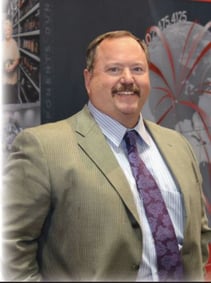
On February 12, 2015, Gary Harpster, Duncan Aviation Avionics Sales Rep, suddenly fell back in his chair and died.
In his own words, Gary tells how a day, much like any other, ends with getting a second chance.
The day began much like any other work day, and I found myself going through my regular routines at Duncan Aviation- a few fire drills for customers who needed things right away, a couple of conference calls and the normal internal meetings.
After 5 p.m., the day was starting to wind down. It was cold outside, so I remotely started my car hoping it would be warm by the time I got in it. I was in the office shutting down my computer when I died. To say the least, it wasn't exactly what I had planned for the evening. But thankfully, there were still two people in the office with me.
While one called 911, the other person jumped up, checked my vitals and started CPR. They also called our company’s First Response Team. In less than five minutes (the typical response time), two individuals arrived and took control of the emergency situation. Both of these individuals previously received training in first aid and CPR from the American Heart Association as well as our local community college. With no pulse and the other symptoms, they made the decision to hook up the automated external defibrillator and push the button as prompted.
Thank goodness for their swiftness and advanced training or this article would certainly have been written by someone else. With the current Health Insurance Portability and Accountability Act in place, I'm not at liberty to expound on some of the other success stories the company’s First Response Team has encountered. But I can say that their involvement has made a world of difference in a lot of lives.
In 2012, they responded to 56 calls at our Lincoln, Nebraska, facility; 48 in 2013, and 33 in 2014. With more than 1,200 employees at this facility, this averages to approximately 3.8 percent of our employee count. As you can imagine, the company’s goal is to get this number down to zero.
By implementing safety seminars, enforcing safety procedures and wellness programs, we have all become more cognizant of our surroundings and well-being. But sometimes a little piece of plaque can just break loose and everything changes. The reason for this article, though, is to inform companies of the merits of having a First Response Team within your organization. My doctors unequivocally stated that without our team's involvement, I would not have survived this ordeal.
Developing A First Response Team
So what does it take to put together a First Response Team? Surprisingly, within your organization, you likely may already have what it takes with volunteer firemen or individuals with current first-aid training. These individuals are perfect for this role, as they've already been trained and have the right moral fiber to help others in need. Once you have your team assembled and enough people to cover your current shifts and weekends, you simply need a first-aid kit and, if possible, an AED and/or portable oxygen tank. A company-wide communication tool also is desirable, but a simple public address system is enough to get started.
Even though you may not initially be able to purchase the AED, put one in your budget and plan accordingly; you' II be glad you did if the need ever arises. The ideal situation would be to have one at each hangar to minimize delays in your team's response times.
More often, avionics shops see AEDs in the corporate jets they maintain. As valuable as they can be on the ground, their potential in the air cannot be overemphasized. If a person's heart goes into ventricular fibrillation, you have four minutes or less before you risk potential brain damage due to a lack of oxygen. After four minutes, your primary concern will be CPR.
Survival decreases rapidly with time. After seven to nine minutes, your survival rate is low. As you can imagine in an aircraft at cruise altitude, this isn't much time. Even though we all try to maintain our health, you never know when something like this can happen. When it does, you either concede to be at the mercy of the local emergency services, or you initiate some control of your own destiny and buy yourself some time by implementing a First Response Team.
Speaking from firsthand knowledge, I'm very grateful that 20 years ago our company saw the benefits of such a team and that these individuals gave me a second chance.


